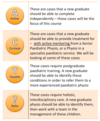M1 L1b: PASSWORD to PRACTICE Intro Flashcards
(30 cards)
What is Password to Practice?

What Does C stand for in CASE?
Context
What does A stand for in CASE?
Alternatives
What does S stand for in CASE?
Selection
What does E stand for in CASE?
Evaluation
What are 2 the acronym in C (Context)?
- CHECK
- CONSIDER
What does CHECK stand for in C (Context)?
- C- Chart
- H- History
- E- Examine
- C- Confer
- K- Knowledge
What are 6 things to CONSIDER in C (Context)?
- Cause of current problem
- Why the child has been referred to physio?
- Condition, comorbidities & development
- General –> Eg. sprained ankle VS cystic fibrosis
- Child rights & family priorities
- Right for child to have physio
- Context of Individual & Environment
- Personal and environmental factors (Gender, culture)
- Communication and Comprehension
- Whether they are able to communicate well (eg. young children or brain injuries)
- Compotence and Confidence of team members
What is the 2 acronyms for A(Alternatives)?
- ACT?
- DELIVER
What is the acroymn for S(Selection)?
WATCH
What are the 2 acroymns for Evaluation?
- CHECK
- SWOT
What does the ICF: Asessment Recording Sheet look like?

What are the 5 headings for the the ICF: Assessment Recording Sheet?
- BF & S (body functions and structures)
- Activity
- Participation
- Environmental factors
- Personal factors
What are the 5 features of the BF & S (Body function and structures) in the ICF Assessment Recording Sheet?
- Neurological (Tone, spasticity, stretch reflexes, invol. movts)
- Infant Patterns (early responses to exteroceptive stimuli)
- Sensory Motor (Vision, Tactile, Proprioception, Vesitbular)
- Postural Control (Orientation & balance)
- Musculo-skeletal
What are the 3 features of Activity in the ICF Assessment Recording Sheet?
- Gross Motor Skills (Positions & Transitions)
- Positions (standing up, sitting down
- Transitions (rolling over, walking, crawling)
- Fine Motor Skills (Hand & Upper Limb)
- Oral Motor Skills (Chew, swallow, motor speech)
What are the 3 features of Participation in the ICF Assessment Recording Sheet?
- Self-Care (including rest, showering, eating, dressing)
- Productivity (Education, Occupation - Purpose for children (eg. daycare or school or part-time jobs))
- Leisure (Recreation- Eg. Participation in sport (children with neurological problems) –> fitness, meeting friends)
What are the 2 features of Environmental factors in the ICF Assessment Recording Sheet?
- Physical
- e1 Equipment & Technology
- e2 Physical & Man Made Environment
- Social (eg. at school)
- e3 Attitudes
- e4 Supports/Relationships (Teachers, parents)
- e5 Services, Systems & Policies (Eg. Funding to access information)
What are the 2 features of Physical Environmental factors in the ICF Assessment Recording Sheet?
- e1 Equipment & Technology
- e2 Physical & Man Made Environment
What are the 2 features of Social Environmental factors in the ICF Assessment Recording Sheet?
- e3 Attitudes
- e4 Supports/Relationships
- e5 Services, Systems & Policies
What are the 6 features of Personal factors in the ICF Assessment Recording Sheet?
- Age
- Gender
- Culture
- Generation
- Location
- Preferences (Likes and don’t likes)
Unable to be changed
What are the 2 contextual factors for the ICF Assessment Recording Sheet?
- Environmental factors
- Personal factors
What do you need to do for C (Chart) in CHECK?
What information do you need from the medical chart?
- Age
- Diagnosis
- Previous medical history
- Growth, development
What do you need to do for H (History) in CHECK?
What are the key points to ask in your parent interview?
- Check info from chart
- Developmental milestones (on time?)
- Sensory performance (sand, playdough, jelly)
- Auditory performance (follow instructions, respond to their name)
What do you need to do for E (Examine) in CHECK?
What are the priorities for physical examination?






